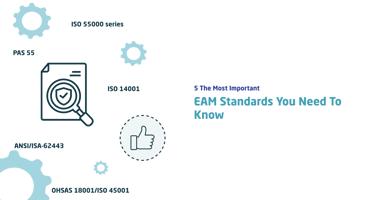
When you purchase a hair dryer or a vacuum cleaner, a small part of you is always worried about whether it is worth the money, whether it will perform, and whether it will be used.
We perceive purchases through the prism of performance, costs, and risk.
Yes, that’s right: the physical asset management approach to value.
Now, imagine the added worries when you’re considering a new EAM software for your multi-million dollar plant or organization.
KEY TAKEAWAYS
- Cost-benefit analysis is a valuable tool when considering the purchase of a new Enterprise Asset Management (EAM) system - it will help you determine if investing in a new EAM system is financially viable.
- If you’re any type of stakeholder in an EAM system, GET INVOLVED FROM THE BEGINNING. This will enable you to participate in the evaluation and selection process
- To overcome resistance to change, apply communication plans, pilot programs, easy wins, demonstrations, and change champions. Let technicians try out the software and its functions - address the benefits and encourage their engagement
- The key to the smooth integration of EAM software with other systems is proactive risk management, skilled teams, and thorough planning.
What if You Get It Wrong?
Whether you’re a maintenance manager, IT leader, procurement manager, or plant director, getting a new EAM software scoped, planned, purchased, integrated, and deployed successfully is a big undertaking.
And it is inherent with risks and unknowns.
Unanticipated risks and uncertainties can cost you money and degraded performance.
Do Something About It
The first thing to do is recognize you have worries
This is normal. This is healthy. It means you are considering the risks, and you are preoccupied with delivering something that adds value to your organization.
And that it makes people’s lives a bit easier.
So, recognize your worries and concerns, and find out what you can do about them.
Here’s our top 10:
Cost
1. "It might be too expensive for us"

This is the top of most people’s concerns (but it shouldn’t be – we’ll come to that shortly). The costs of a new EAM software can include:
- Purchase (SaaS or lifetime license)
- Integrations
- Training
- Support
- Upgrades
Everything has purchase and running costs, even the humble hair dryer: you buy it but you also need electricity for it to function.
EAM software is no different
Perform a cost-benefit analysis, but also consider the costs of not improving and upgrading. Look at several EAM providers and select one on a scored criteria that mean the most to your organization.
2. "We won’t get value out of it in the long run"
Don’t buy on cost alone - buy on long-term value.
Remember that sentence and the old, unattributed idiom: buy cheap, buy twice.
This ties back to the first point about understanding what your organization needs from the EAM software and scoring the vendors and products on a specific criterion.
You will likely not end up buying the cheapest EAM product but in the long term, the better ones will deliver you value in ease of use, functionality, service reliability, flexibility, scalability, mobility, and integrate-ability.
We made that last word up.
But they will all save you money in the long run.
Performance
3. "It probably can’t do what we want"
This can be a concern if you haven’t been involved in the procurement process.
Imagine you’re a maintenance manager at the coffee machine. The procurement manager sidles up to you. He looks sheepishly at you as he selects his americano. ‘By the way, that new EAM software we bought is being installed next week… and we’re… ermm… we’re getting rid of your CMMS.’
You drop your hot cappuccino.
‘So… ermm… can you send me your full asset list and all your PMs by Thursday. We need to upload them ASAP.'
‘But what about the all the eng-.’
‘See ya later.’
Nightmare stuff.

If you’re any type of stakeholder in an EAM system (maintenance manager, reliability engineer, procurement manager, production manager, and so on), then GET INVOLVED FROM THE BEGINNING.
It’s so important that we put it in capitals.
If you don’t get involved, you won’t get the opportunity to evaluate it and request changes, modifications, or even a different EAM software.
4. "We’re not sure if it can handle maintenance management"
This is a valid worry for anyone in the maintenance team – especially if the EAM is taking the place of the old, trusted, standalone CMMS.
There is a perception that EAMs are only for finance, procurement, and production
This is no longer even partially true.
Modern EAM software and systems are built to include all the functionality of CMMS: work requests, work order management, asset registers, asset locations, spare parts management, planning, scheduling, permits, dashboards, analytics, KPIs, and so on.
Get to know the proposed EAM. Make sure it can manage your maintenance.
5. "We’ll get left behind if we don’t do the upgrades"
There is another common misconception that software upgrades will leave people and organizations behind, technologically speaking.
This is often not true, as most upgrades are gradual, small improvements.
Small changes to source code, a new button here, or a different layout there.
Discuss with your potential EAM provider to see if or what the charges are for upgrades.Often, you may be surprised to hear, they are free.
Risk
6. "Technicians won’t use it"
In maintenance environments, there is often a reluctance from technicians and engineers to use a CMMS or EAM for recording work.
Every individual is different.
But many times, when someone who is most comfortable with tools in their hands must interact with software, it causes them a mild irritation or a silent, dignified, stoic, rejection of the process.
This rejection or even superficial usage of a CMMS will choke data, knowledge, reliability improvement, analytics, and KPIs for the organization.
Not a good thing.
To overcome this, get them involved early in the procurement process. Let the tradespeople try out the software, the app, and the functions.
Sell the benefits to them. Address the ‘What’s in it for me?’ question.
7. "The maintenance team doesn’t like change"
Does anyone?
Change is hard. Even though it is most often for the best, people will still resist. They like the status quo; the way things are.
Maintenance teams are no different.
A bad, toxic, unchanging culture can destroy any efforts or progress of technological change.

Teams are certainly not always toxic, but they often resist change. If your organization has this challenge, then it goes back to culture change and communicating the benefits of the change
Use communication plans, pilot programs, easy wins, demonstrations, and change champions.
A great place to start is Kotter’s 8 step model of change
8. "Its functionality is probably too complicated to understand"
Modern software has become more functional. More capable.
Some would argue that it is more complicated.
But even if that is partially true, it has become sleeker and more usable. Modern software is always designed with time and cost saving in mind.
If you have any concerns about functionality and ease of use, then get a live demo from the EAM provider
On-site or remote, they will be happy to oblige.
9. "Vendor support may be poor"
Like in any walk of life, when it comes to service providers, you’ll get the poor, the good, and the great.
You need to know the capability and reliability of the EAM vendor because your business will need to interact closely with it
Why not have a sit down with them and get to know them better:
Have you implemented this software in my industry before?
What does customer support consist of during and after implementation?
Is support included in the pre-and post-implementation?
How many support hours do your clients need annually?
Can we speak to one of your current clients?
10. "We can’t bear to think about the inevitable integration and IT problems"
EAM software will need to integrate with other parts of the IT infrastructure. This may be a CMMS or ERP system, among others.
Integrations can be terrifying for IT managers and project engineers.
You need software to talk to each other upon integration. But, quite often, this is problematic.
Integration risks must be considered.
The key to smooth integrations is risk management and planning:
- Proactively identify risks and mitigating actions
- Use a skilled and knowledgeable team
- Plan the mitigating actions
Calm your nerves
These are what we believe to be the top 10 worries for anyone choosing a new EAM software.
And it is normal to have decision anxiety regarding costs, performance, and risks with any purchase, let alone a ‘big ticket’ item like an EAM system.
Consider what we’ve talked about here and what you can proactively do about it.
Address these concerns diligently, and you won’t go far wrong.
.png?width=388&height=200&name=Copy%20of%20Blog%20Featured%20Image%20(4).png)




